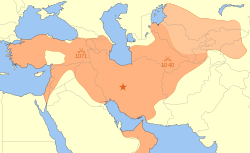ผลต่างระหว่างรุ่นของ "จักรวรรดิเซลจุค"
เนื้อหาที่ลบ เนื้อหาที่เพิ่ม
ไม่มีความย่อการแก้ไข ป้ายระบุ: แก้ไขจากอุปกรณ์เคลื่อนที่ แก้ไขจากเว็บสำหรับอุปกรณ์เคลื่อนที่ |
ล wikidata interwiki |
||
| บรรทัด 88: | บรรทัด 88: | ||
[[หมวดหมู่:สิ้นสุดในคริสต์ศตวรรษที่ 12]] |
[[หมวดหมู่:สิ้นสุดในคริสต์ศตวรรษที่ 12]] |
||
{{โครงประวัติศาสตร์}} |
{{โครงประวัติศาสตร์}} |
||
[[az:Səlcuqlular]] |
|||
[[be-x-old:Сэльджукі]] |
|||
[[bg:Селджуци]] |
|||
[[bs:Seldžuci]] |
|||
[[de:Seldschuken]] |
|||
[[el:Σελτζούκοι]] |
|||
[[eo:Turko-Selĝukoj]] |
|||
[[fr:Seldjoukides]] |
|||
[[fy:Seltsjoeken]] |
|||
[[hr:Seldžuci]] |
|||
[[hu:Szeldzsuk törökök]] |
|||
[[it:Selgiuchidi]] |
|||
[[kk:Салжұқтар]] |
|||
[[ku:Selçûqî]] |
|||
[[la:Selgiukidae]] |
|||
[[lt:Seldžiukai]] |
|||
[[nl:Seltsjoeken]] |
|||
[[nn:Seldsjukkar]] |
|||
[[no:Seldsjukkene]] |
|||
[[ru:Сельджуки]] |
|||
[[sv:Seldjuker]] |
|||
[[tk:Seljuklar]] |
|||
[[uk:Сельджуки]] |
|||
รุ่นแก้ไขเมื่อ 18:33, 19 มกราคม 2564
มหาจักรวรรดิเซลจุค شاهنشاهی بزرگ سلجوقی Shahanshahie Bozorge Saljugh | |
|---|---|
| ค.ศ. 1037–ค.ศ. 1194 | |
 จักรวรรดิเซลจุคอันยิ่งใหญ่ในสมัยที่รุ่งเรืองที่สุดในปี ค.ศ. 1092 เมื่อสุลต่านมาลิค ชาห์ที่ 1 เสด็จสวรรคต | |
| เมืองหลวง | นิชาเพอร์ เรย์ |
| การปกครอง | โดยพฤตินัย: รัฐสุลต่านอิสระ โดยนิตินัย: ภายใต้รัฐเคาะลีฟะฮ์[1] |
| เคาะลีฟะฮ์ | |
• 1031–1075 | Al-Qa'im |
• 1180–1225 | Al-Nasir |
| สุลต่าน | |
• 1037–1063 | Toghrul I (first) |
• | Toghrul III (last)[2] |
| ประวัติศาสตร์ | |
• Tugrul Beg ก่อตั้งเป็นรัฐ | ค.ศ. 1037 |
• มาแทนด้วยจักรวรรดิ Khwarezmian[3] | ค.ศ. 1194 ค.ศ. 1194 |
| ประวัติศาสตร์อิหร่านแผ่นดินใหญ่ | ||||||||||||||||||||||||||||||||||||||||||||||||||||
|---|---|---|---|---|---|---|---|---|---|---|---|---|---|---|---|---|---|---|---|---|---|---|---|---|---|---|---|---|---|---|---|---|---|---|---|---|---|---|---|---|---|---|---|---|---|---|---|---|---|---|---|---|
 | ||||||||||||||||||||||||||||||||||||||||||||||||||||
| กษัตริย์แห่งเปอร์เชีย | ||||||||||||||||||||||||||||||||||||||||||||||||||||
| ก่อนยุคใหม่ | ||||||||||||||||||||||||||||||||||||||||||||||||||||
|
ก่อน อิสลาม
| ||||||||||||||||||||||||||||||||||||||||||||||||||||
|
หลัง อิสลาม
| ||||||||||||||||||||||||||||||||||||||||||||||||||||
|
ยุคใหม่
| ||||||||||||||||||||||||||||||||||||||||||||||||||||
| ||||||||||||||||||||||||||||||||||||||||||||||||||||
| ||||||||||||||||||||||||||||||||||||||||||||||||||||
| ||||||||||||||||||||||||||||||||||||||||||||||||||||
| ||||||||||||||||||||||||||||||||||||||||||||||||||||
| ||||||||||||||||||||||||||||||||||||||||||||||||||||
| ||||||||||||||||||||||||||||||||||||||||||||||||||||
| ||||||||||||||||||||||||||||||||||||||||||||||||||||
มหาจักรวรรดิเซลจุค (เปอร์เซีย: سلجوقیان) เป็นจักรวรรดิแบบเปอร์เชีย[4][5][6][7] ของยุคกลางของซุนนีมุสลิมของชนเซลจุคเตอร์กของเตอร์โค-เปอร์เชีย[8] ที่ก่อตั้งโดยสาขา Qynyq ของ เตอร์โคมัน[9] ที่มีอำนาจครอบครองอาณาบริเวณอันกว้างใหญ่ตั้งแต่เทือกเขาฮินดูกูช ไปถึงทางตะวันออกของอนาโตเลียและจากเอเชียกลางไปจนถึงอ่าวเปอร์เซีย เซลจุคตั้งต้นมาจากดินแดนบ้านเกิดใกล้ทะเลอารัล และขยายอำนาจไปยังเกรตเตอร์โคราซาน และต่อไปยังเกรตเตอร์อิหร่านก่อนจะไปสิ้นสุดลงที่ทางตะวันออกของอนาโตเลีย
การก่อตั้งราชวงศ์
ส่วนนี้รอเพิ่มเติมข้อมูล คุณสามารถช่วยเพิ่มข้อมูลส่วนนี้ได้ |
ดูเพิ่ม
อ้างอิง
Citations
- ↑ Holt, Peter M. (1984). "Some Observations on the 'Abbāsid Caliphate of Cairo". Bulletin of the School of Oriental and African Studies. University of London. 47 (3): 501–507. doi:10.1017/s0041977x00113710.
{{cite journal}}:|ref=harvไม่ถูกต้อง (help) - ↑ Grousset, Rene, The Empire of the Steppes, (New Brunswick: Rutgers University Press, 1988), 167.
- ↑ Grousset, Rene, The Empire of the Steppes, (New Brunswick:Rutgers University Press, 1988),159,161.
- ↑ M.A. Amir-Moezzi, "Shahrbanu", Encyclopaedia Iranica, Online Edition, (LINK): "... here one might bear in mind that non-Persian dynasties such as the Ghaznavids, Saljuqs and Ilkhanids were rapidly to adopt the Persian language and have their origins traced back to the ancient kings of Persia rather than to Turkish heroes or Muslim saints ..."
- ↑ Josef W. Meri, "Medieval Islamic Civilization: An Encyclopedia", Routledge, 2005, p. 399
- ↑ Michael Mandelbaum, "Central Asia and the World", Council on Foreign Relations (May 1994), p. 79
- ↑ Jonathan Dewald, "Europe 1450 to 1789: Encyclopedia of the Early Modern World", Charles Scribner's Sons, 2004, p. 24: "Turcoman armies coming from the East had driven the Byzantines out of much of Asia Minor and established the Persianized sultanate of the Seljuks."
- ↑ Possessors and possessed: museums, archaeology, and the visualization of history in the late Ottoman Empire; By Wendy M. K. Shaw; Published by University of California Press, 2003, ISBN 0520233352, 9780520233355; p. 5.
- ↑
- Jackson, P. (2002). Review: The History of the Seljuq Turks: The History of the Seljuq Turks.Journal of Islamic Studies 2002 13(1):75-76; doi:10.1093/jis/13.1.75.Oxford Centre for Islamic Studies.
- Bosworth, C. E. (2001). Notes on Some Turkish Names in Abu 'l-Fadl Bayhaqi's Tarikh-i Mas'udi. Oriens, Vol. 36, 2001 (2001), pp. 299-313.
- Dani, A. H., Masson, V. M. (Eds), Asimova, M. S. (Eds), Litvinsky, B. A. (Eds), Boaworth, C. E. (Eds). (1999). History of Civilizations of Central Asia. Motilal Banarsidass Publishers (Pvt. Ltd).
- Hancock, I. (2006). ON ROMANI ORIGINS AND IDENTITY. The Romani Archives and Documentation Center. The University of Texas at Austin.
- Asimov, M. S., Bosworth, C. E. (eds.). (1998). History of Civilizations of Central Asia, Vol. IV: The Age of Achievement: AD 750 to the End of the Fifteenth Century, Part One: The Historical, Social and Economic Setting. Multiple History Series. Paris: UNESCO Publishing.
- Dani, A. H., Masson, V. M. (Eds), Asimova, M. S. (Eds), Litvinsky, B. A. (Eds), Boaworth, C. E. (Eds). (1999). History of Civilizations of Central Asia. Motilal Banarsidass Publishers (Pvt. Ltd).
แหล่งที่มา
- Peacock, A.C.S.; Yıldız, Sara Nur, บ.ก. (2013). The Seljuks of Anatolia: Court and Society in the Medieval Middle East. I.B.Tauris. ISBN 978-1848858879.
{{cite book}}:|ref=harvไม่ถูกต้อง (help) - Mecit, Songül (2014). The Rum Seljuqs: Evolution of a Dynasty. Routledge. ISBN 978-1134508990.
{{cite book}}:|ref=harvไม่ถูกต้อง (help)
อ่านเพิ่มเติม
- Previté-Orton, C. W. (1971). The Shorter Cambridge Medieval History. Cambridge: Cambridge University Press.
- Tetley, G. E. (2008). The Ghaznavid and Seljuk Turks: Poetry as a Source for Iranian History. Abingdon. ISBN 978-0-415-43119-4.
- Stokes, Jamie, บ.ก. (2008). Encyclopedia of the Peoples of Africa and the Middle East. New York: Facts On File. ISBN 978-0-8160-7158-6. คลังข้อมูลเก่าเก็บจากแหล่งเดิมเมื่อ 2017-02-14.
{{cite book}}:|ref=harvไม่ถูกต้อง (help)
แหล่งข้อมูลอื่น
- http://global.britannica.com/EBchecked/topic/533602/Seljuq
 Houtsma, Martin Theodoor (1911). . สารานุกรมบริตานิกา ค.ศ. 1911 (11 ed.).
Houtsma, Martin Theodoor (1911). . สารานุกรมบริตานิกา ค.ศ. 1911 (11 ed.).
